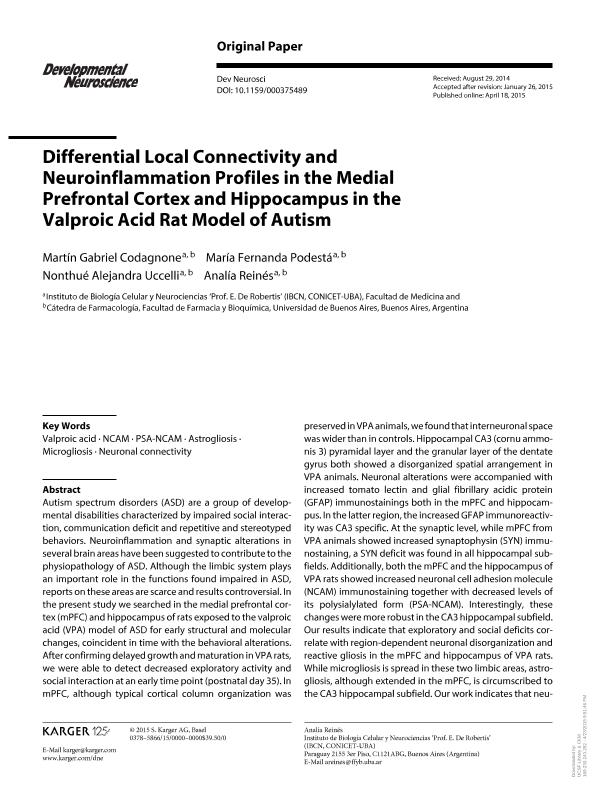Artículo
Differential local connectivity and neuroinflammation profiles in the medial prefrontal cortex and hippocampus in the valproic acid rat model of autism
Codagnone, Martín Gabriel ; Podestá, María Fernabda
; Podestá, María Fernabda ; Uccelli, Nonthué Alejandra
; Uccelli, Nonthué Alejandra ; Reines, Analia Gabriela
; Reines, Analia Gabriela
 ; Podestá, María Fernabda
; Podestá, María Fernabda ; Uccelli, Nonthué Alejandra
; Uccelli, Nonthué Alejandra ; Reines, Analia Gabriela
; Reines, Analia Gabriela
Fecha de publicación:
07/2015
Editorial:
Karger
Revista:
Developmental Neuroscience
ISSN:
0378-5866
e-ISSN:
1421-9859
Idioma:
Inglés
Tipo de recurso:
Artículo publicado
Clasificación temática:
Resumen
Autism spectrum disorders (ASD) are a group of developmental disabilities characterized by impaired social interaction, communication deficit and repetitive and stereotyped behaviors. Neuroinflammation and synaptic alterations in several brain areas have been suggested to contribute to the physiopathology of ASD. Although the limbic system plays an important role in the functions found impaired in ASD, reports on these areas are scarce and results controversial. In the present study we searched in the medial prefrontal cortex (mPFC) and hippocampus of rats exposed to the valproic acid (VPA) model of ASD for early structural and molecular changes, coincident in time with the behavioral alterations. After confirming delayed growth and maturation in VPA rats, we were able to detect decreased exploratory activity and social interaction at an early time point (postnatal day 35). In mPFC, although typical cortical column organization was preserved in VPA animals, we found that interneuronal space was wider than in controls. Hippocampal CA3 (cornu ammonis 3) pyramidal layer and the granular layer of the dentate gyrus both showed a disorganized spatial arrangement in VPA animals. Neuronal alterations were accompanied with increased tomato lectin and glial fibrillary acidic protein (GFAP) immunostainings both in the mPFC and hippocampus. In the latter region, the increased GFAP immunoreactivity was CA3 specific. At the synaptic level, while mPFC from VPA animals showed increased synaptophysin (SYN) immunostaining, a SYN deficit was found in all hippocampal subfields. Additionally, both the mPFC and the hippocampus of VPA rats showed increased neuronal cell adhesion molecule (NCAM) immunostaining together with decreased levels of its polysialylated form (PSA-NCAM). Interestingly, these changes were more robust in the CA3 hippocampal subfield. Our results indicate that exploratory and social deficits correlate with region-dependent neuronal disorganization and reactive gliosis in the mPFC and hippocampus of VPA rats. While microgliosis is spread in these two limbic areas, astrogliosis, although extended in the mPFC, is circumscribed to the CA3 hippocampal subfield. Our work indicates that neuroinflammation and synaptic alterations do coexist in VPA rats, making this model suitable for studying novel aspects of neuron-glia interactions. Moreover, it suggests that the mPFC and hippocampus might behave differently in the context of the local hyperconnectivity and synaptic hypotheses of autism.
Palabras clave:
ASTROGLIOSIS
,
MICROGLIOSIS
,
NCAM
,
NEURONAL CONNECTIVITY
,
PSA-NCAM
,
VALPROIC ACID
Archivos asociados
Licencia
Identificadores
Colecciones
Articulos(IBCN)
Articulos de INST.DE BIOLO.CEL.Y NEURCS."PROF.E.DE ROBERTIS"
Articulos de INST.DE BIOLO.CEL.Y NEURCS."PROF.E.DE ROBERTIS"
Citación
Codagnone, Martín Gabriel; Podestá, María Fernabda; Uccelli, Nonthué Alejandra; Reines, Analia Gabriela; Differential local connectivity and neuroinflammation profiles in the medial prefrontal cortex and hippocampus in the valproic acid rat model of autism; Karger; Developmental Neuroscience; 37; 3; 7-2015; 215-231
Compartir
Altmétricas



